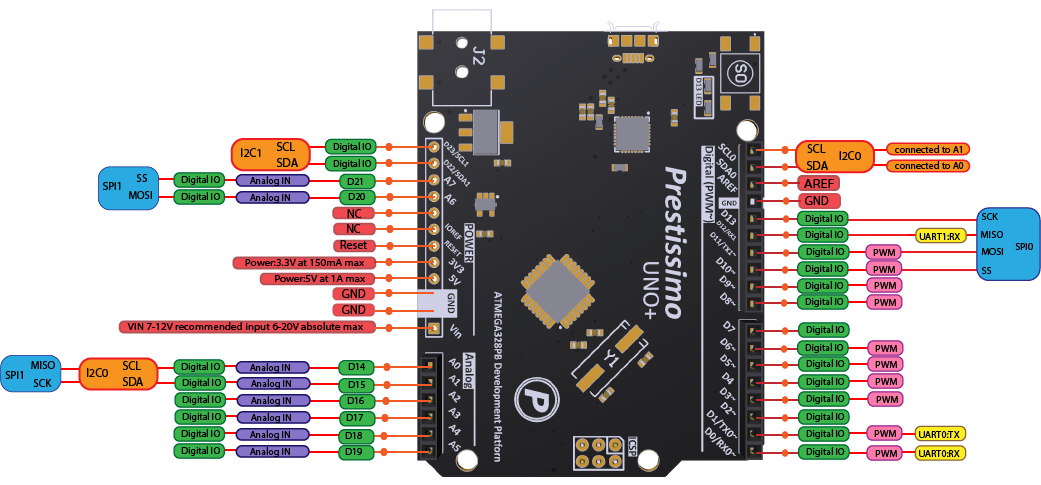The Prestissimo Uno+ is a platform for rapid electronics development and prototyping that brings us the simplicity, ease of use and reliability of the Arduino Uno but with extended functionality.
Despite numerous other options, the Arduino Uno has remained the most popular electronics prototyping platform for makers, engineers and hobbyists alike. At the heart of its success is the simplicity, ease of use and reliability of the AVR microcontroller. Unfortunately the Arduino Uno has an extremely limited feature set. Many times makers and developers are forced to compromise their design or to move to more complex platforms increasing time-to-market and making DIY projects less doable.
The Prestissimo Uno+ uses the new ATmega328PB microcontroller - an updated version of the Arduino Uno's ATmega328P microcontroller. The "PB" version of the MCU builds on pre-existing functionality to include more SPI, UART and I2C ports (two of each instead of one), 9 PWM channels instead of 6, 8 ADC channels instead of 6, and 24 IO instead of 20 among other improvements. As the micro-controllers are so similar, full Arduino Uno compatibility is maintained meaning you get increased functionality while preserving the Arduino Uno experience.
Prestissimo Uno+ makes electronics more accessible for maker and hobbyists while reducing debugging cycles, hardware re-spins, time to market and ultimately development costs for the developer.
Prestissimo Uno+ is also one of the few development platforms for the new ATmega328PB chip currently available meaning Prestissimo Uno+ is perfect for those who just want to play with the new chip as well.
Prestissimo Uno+
Prestissimo Uno+
Advantages of the Prestissimo Uno+Additional hardware serial ports: No more bit banging! The need for a second UART port ( and one that is not shared with USB) on the Arduino Uno is so great that the "SoftwareSerial" library in included in the Arduino IDE. It emulates additional serial ports through "bit banging" (toggling of IO to emulate TTL serial). Consuming large amounts of processing power and memory, it is extremely inefficient and performs poorly when compared to hardware serial. With the Prestissimo Uno+, these problems disappear as there is an additional hardware serial port. Implementation is easy.
Prestissimo Uno+
A second I2C bus: Your address clashes resolved! I2C is an extremely common interface used to by sensors, displays memory devices etc. to communicate with Arduino. Multiple devices can be connected to the bus provided they have unique addresses. Address clashes can occur coincidentally but also when you need to connect a number of the same device to the bus as I2C slaves have either fix addresses or a limited number of programmable addresses. One the Arduino Uno the only solution is to increase the complexity of the design by adding an I2C bus multiplexer. This hurdle is overcome with the Prestissimo Uno+. It has a second I2C bus, if there is an address clash, this IC can be moved to the second bus.
More PWM channels: For motors, robotics, actuators and more! With Prestissimo Uno+ you get an extra 4 PWM channels. You can now control more motors, actuators, LEDs making the Prestissimo Uno+ perfect for robotics and even RC vehicle applications. There is no longer a need to add complex PWM controllers to your design to extend PWM outputs.
More ADC channels: Monitor more sensors! With an extra 2 analog inputs, you can now monitor more inputs without purchasing an input multiplexer or discrete ADC.
A second SPI bus: Simplify wiring! If long lengths of wire (lots of messy jumpers on a breadboard)are used to connect multiple SPI devices data corruptions issues may arise, especially if wiring the bus is running at highspeed. Splitting devices across the two SPI controllers on the Prestissimo Uno+ can shorten the length of your jumper wires reducing the chance of the bus operating correctly. For data logging applications: dedicate one bus to your SD card (run the bus at high speed) and use the other to monitor sensors.
More GPIO: for when your running short on pins! While the Arduino Uno has 20 GPIO pins, Prestissimo Uno+ has 24. There is no longer a need to bother with complex shift registers, muxes and io expanders - simplfy your design. You can drive a high pinout devices such as an 8x8 LED matrix directly from your Prestissimo Uno+. This will take 16 pins leaving you with only 4 to spare on an Arduino Uno. This is likely not enough for your project. On the Prestissimo Uno+ you would have 8 pins to spare which is a decent amount left to play with.
Pin out Diagram
Reference printed on the back! You are familiar with the normal Arduino pinout but the Prestissimo Uno+ has features present on other pins. We've made it easy to remember which pins can do what by printing a pin out reference guide on the back of the board to make it easy to remember which pins are which.
Pinout guide print on the back side of the board
Detailed Comparison




Comments
Please log in or sign up to comment.